In modern gardening, there are a huge number of colors that will become an excellent decoration of any plot. Many species of colors are quite famous among the gardeners, others are only gaining their popularity. Undoubtedly, the most popular colors at all times were gladiolus.
These beautiful and bright arrows fill the flower garden with an incredible atmosphere and a charming aroma. Amateur gardeners often ask a question whether gladiolus can be grown in pots. Of course, these gentle flowers you can easily plant in a suitable container or pot, and then decorate your site, a balcony or loggia with a similar composition. Gladiolus in pots, landing and care for which is practically no different from the grown in the garden, will become an interesting and original garden decoration.
In this article, consider the peculiarities of how to grow gladiolus in pots, how to choose the rightness of gladioles to fit into containers. We note the most important nuances of landing and care for gladiolus in pots.
Features and description of gladiols
The gladiolus flower is a perennial clubnelukovic plant, which belongs to the family of the lords. These flowers are known for a long time. In nature, gladioluses grow on the territory of South Africa, Europe and Asia and there are approximately 200 diverse species. Translated from the Latin word "gladiolus" indicates the "sword" that it is impossible to better describe the appearance of this majestic flower. In ancient Greece 300 years BC Gladiolus was considered conventional weeds, but today it is, perhaps, one of the most popular and most beautiful colors. Growing on its plot of gladiolus every gardener considers almost duty. And with the help of new varieties derived by breeders, these flowers can be grown in garden pots or containers, as well as in room vases, which makes gladiolus even more magnificent.
Gladiolus description:
- Gladiolus are perennial plants that multiply on bulbs children. All sorts are most often thermal-loving, as the natural habitat is the southern regions. That is why in our climate, gladioluses are digging for the winter. When growing gladioles in the pots, you can pick up containers in the cold season in the cold season, and in the spring again put on fresh air.
- Gladiolus have a rather developed root system, so for planting tubers it is necessary to pick up suitable containers or pots.
- Gladiolus bulbs are updated every year, give all their vitality and nutrients to new tubers. Due to this, bulbs kids are formed, which are planting material.
- Stems in these colors grow vertically up and are represented. The height of plants depends on the specific type and variety of gladiolus and is approximately 50-150 cm, in some cases 200 cm.
- Along the stems grow long and narrow, linear and sword-shaped leaves, whose length on average reaches 50-80 cm.
- Flowers of gladioles have a form of funnels and are of various sizes. They consist of 6 petals of a wide variety of shades: white, red, pink, purple, yellow and others.
- Flowers are collected in a co-shaped inflorescence, which in length reaches 60-80 cm.
- The form of petals can also be the most different: corrugated, simple, folded, terry, dragon.
- During flowering on one blossom, it may bloom from 15 to 22 colors.
- To date, there is a rather complicated classification of gladiols that allow us to facilitate the choice of the variety you need. About 2000 diverse varieties are derived from breeders, which are characterized by the peculiarities of the appearance, flowering period, colorful colors, sizes of colors.
- Each variety of gladiolus is assigned a specific digital code in which the first figure indicates the size of the colors: 1-6.5 cm, 2 - 6.5-9 cm, 3 - 9-11.5 cm, 4 - 11.5-14 cm, 5 - from 14 cm. Mini (6.5 cm), small-ceiling varieties (6.5 cm), minnial varieties of gladiolus (9-11.5 cm) are suitable for landing of gladiolus in the pot. The following two digits indicate the color of the petals of gladiolus, for example 01 it is white. If the code is present in the code, it denotes the period of flowering of a specific gladiolus variety. All these parameters facilitate classification and choice of colors.
Gladiolus varieties for planting pots
Gladiolus are very strong and quickly grow up, so it is necessary to choose certain varieties in pots on the street in the street, which grow up at about 25-60 cm in height. This colors include mini-varieties of gladiolus, small-ceiling and firmlywater varieties of this plant. If you use a rather bulky container for landing, then you can try to plant large-flowered varieties. Let us give a description of the most popular gladiolous varieties for container growing.
- Sort Gladiolus "White City". This flower refers to the primuil group. The diameter of colors on average can be 3.5-7.5 cm, which relates this variety to the meannail. During flowering, inflorescence can consist of 23 colors of a snow-white shade.
- Grade "Columbine". This variety also applies to primurate, has a small size colors. This is a truly royal plant, which is distinguished by bright and colorful inflorescences. Petals of red with white.
- Grade "Tinkerbell". This variety of gladiolus belongs to butterfly or butterfly varieties. On average, this flower can reach 45-75 cm, which is ideal for planting pots. Flowers are collected in bright orange cololoidal inflorescences with yellow yawn.
- Grandiolus variety "Malodi". Flowers are characterized by the inflorescences of a gentle pink shade with a bright red spot in the center. These plants in height can reach the maximum 100 cm.
- Sort "Georgetta". Gladiolus of this variety looks beautifully on any flowerbed or flower bed. They are also suitable for landing in containers and pots. Flowers have red and yellow shades.
- Grade "Moscow Belokamena". A very beautiful and unusual plant, which in height can reach 60 cm. Petals of colors corrugated, simultaneously about 40 pieces can bloom in a co-shaped inflorescence.
- Grade "Bow Pip". This variety of gladiolus refers to the dwarf and in height reaches approximately 45-70 cm. The petals of this plant have a folded shape and painted in a gentle apricot color.
- Sort "Robinett". The height is achieved as much as possible. See perfectly look at both flower beds and flower beds and containers. This variety is distinguished by a bright color of inflorescences - petals have a dark purple shade.
- Grade "Greenberd". Translated the name of this flower is translated as a "green bird", which perfectly describes the appearance of the petals. Gladiolus flowers have a bright green-yellow shade.
Gladolus reproduction for growing pots
Before starting to understand the nuances of how to plant the gladioluses in the pots, it is important to study the issue of reproduction of this plant. There are several ways to reproduce the gladiolus, among which you can note the seed reproduction, reproduction by tuberous and the division of tuberukovits. Having considered the features of each method, you can determine for yourself the best option.
Seed reproduction of gladioles for growing in pots
- This method of breeding is used most often in breeding work to eliminate new varieties of gladiolus.
- When using seed reproduction at home, plants lose such maternal signs like painting of petals, the size of the colors.
- If you still want to try to dilute flowers with seeds, collect planting material with monochromatic painted varieties that grow nearby. So you get the most close to the gladiolus color.
- Seeds need to be heated in February in advance prepared soil. It is also recommended to use a greenhouse for growing gladioles.
- Before sowing seeds, it is important to be treated with a special solution of sodium humate, in which they are withstanding about 2-3 hours.
- In a mixture of leafy humus and sand seeds, seeds are fed.
- In the springtime, containers with seeds can be taken out to the street.
Gladiolus reproductionballcasters for growing in pots
- Various varieties of gladiolus can give a different number of tuber. On one bulb for the season can grow from 15 to 100 tubers, which, in turn, differ in size and germination.
- The club worker is a reduced stem with one scales. Maturation of one kid occurs within 90 days.
- A leaf plate appears at the top of the kids, and root tubercles grow on the bottom.
- For reproduction, children are best suited, the diameter of which is about 0.5-1 cm. If you have a small kids, you can additionally be resolved in a container with a removable bottom and nutritional soil.
- In the spring, you can search for kids on pre-prepared beds to a depth of about 5 cm. After planting abundantly pull the children with water and cover the film. Under the film, gladiolus should germinate for one month.
- If you have seeded medium and large babes, your young gladiolus can be blooming by the end of the season.
The reproduction of gladiolus clubnellukovitsa
- The root system of gladiolus has two tiers. The first is represented by the vegetative organ of the root mother plant, which feeds the replacement bulb and deviates at the end of the season. The second tier is a replacement clubnewuk. It is precisely it is used to reproduce this flower.
- If you land the gladiolus in the spring in the pots, you need to divide the tubnelukovitsa into several parts that will become a landing material.
- You need to share with a sharp knife, first examining the tuberukovitsa. At every part there must be at least one sleeping babe and part of the Donets with roots. Without these components you are unlikely to get a plant.
- Sections of sections It is important to carefully treat with a solution of manganese or charcoal, and then put the decene with the Donetics.
Preparation before landing gladiolus in a pot
Landing the gladioles in a pot or any other container is slightly different from the usual reference process of the bulbs of this plant. In order to deal with correctly in the process of how to plant gladiolus in pots, it is important to carefully prepare and perform all previous landing steps. Consider the features of each preparation stages.
Stage 1. Selection of gladiolus for planting pot
- First of all, special attention should be paid to the bulbs of gladiolus, as it is precisely from them, whether you will grow a full flower.
- If you have already been engaged in growing gladiolus in the garden, you can try to separate the kids for the next planting in the pots or to take the division of clubnellukovits.
- However, in this case, it is worth being very attentive, because for containers and pots are not suitable for gladiolus. The root system of this flower is very growing, so large-flowered varieties are hardly suitable for this ventiy.
- Give preference to dwarf varieties or small beds. Such gladiolus smashes less and will not interfere with each other after planting and during flowering. The optimal height of the adult flower should be approximately 50-60 cm.
- The varieties of gladioles for planting in pots are made important and taking into account the color gamut you need.
- If you want to put the gladioluses in the pots of the house, it is better to purchase in that case dwarf varieties that can have a height of only 30-40 cm.
- Purchase the seating material is recommended in specialized garden centers or nurseries that are engaged in breeding plants. So you will be sure that you get exactly the plant you want.
- It is better to buy a whole healthy bulb without damage and dry sections. It should not be spots of mold or wrinkled sites. The size of the bulbs should be approximately 2-4 cm.
Stage 2. Selection and preparation of container for planting gladioles in pots
- The second important point of preparation before landing the gladioles in the pots is the choice of a suitable container or pot.
- For landing gladiolus, pots can be made of a variety of materials: ceramics, clay, plastic.
- You can pick up a pot, container, porridge, vase for planting gladiolus bulbs. For example, Vazon or Kashpo is perfect for the design of balconies and loggias, and the containers and pots can be used to create a garden composition.
- It is important to pick up the containers taking into account the height of future colors. On average, the diameter of the pot should not be less than 30 cm, and the depth is at least 40 cm. The deeper the acquired pot, the better for the gladiols.
- The pot must necessarily have drainage holes, as this plant absolutely does not end the water stagnation. The pot can be put in a special saucer to flow water there.
Stage 3. Preparation of soil for planting gladiols in pots
- Gladiolus prefer to grow in a nutrient substrate.
- Since a rather large number of gladiolus bulbs is planted in one container, it is important that fertile soil is used.
- It is necessary to purchase light and moisture-permeable soil, which is perfect for planting these colors.
- Such soil can be purchased in specialized garden shops.
The process of planting gladiols in pots
- The optimal time for landing the bulbs of gladiolus in the pots is considered the gap from the end of March to mid-May. However, experts recommend landing the planting material closer to the summer.
- First of all, it is necessary to prepare landing material. For this, all the bulbs need to be cleaned of dry scales, after which they are treated with a special flugicide solution. It is necessary to disinfect tubers so that later the plant is not ill.
- In order to end up to get a beautiful and magnificent flowering plant, experienced gardeners are recommended to soak the tuberukovitsa in the solution of cytovitis by about 6-12 hours.
- You can achieve a good result if you additionally treat the bulbs with special solutions of the rooting agent.
- All this procedures must be carried out approximately 2-3 weeks before landing. All this time, tuberukovitsa must be in an empty and dry container. If 2 weeks later, some bulbs did not let the sprout, they are discarded and not used for landing.
- Next is preparing a pot for landing. It is important for his bottom to pour a good layer of drainage so that the roots do not accumulate a lot of water. As a drainage, you can use broken glue, stones or gravel. Previous material must be well rinsed.
- A layer of nutrient soil is embanked on the drainage layer and moisturize it well.
- After that, you can start planting bulbs. Each bulb is plunged at about 7-12 cm, and the distance between them should be at least 6-7 cm.
- Pots with gladiolus must be placed on a quiet and sunny place. It is also important to take into account that during the flowering period, rainwater should not fall.
Agrotechnology of growing gladioles in a pot: Secrets and nuances of care
Caring for gladiolus, planted in pots or containers, is slightly different from agricultural equipment of growing garden colors. It is necessary to take into account all the moments of care of care, in order to further get beautiful and healthy gladiolus.
Watering gladiols in pots
Gladiolus in pots dry out much more often than planted in a flower bed, so special attention should be paid to the irrigation regime. These flowers do not endure excessive convergence, however, the lack of moisture can kill destructively. The approximate irrigation mode should be 3 times a week, the amount of irrigation can be enlarged during the dry time. During irrigation, make sure that the water does not fall on the flowers and the foliage of the gladiolus, which can start grew from this. You only need to use the indent room temperature.
Ruffle and mulching gladiols
It is important to maintain the soil in pots in good condition. It should be easy and breathable, so it periodically stands to gently loosen soil to ensure air flow to roots. In order not to be excessive evaporation of moisture, the upper part of the soil should be closed. For this, a peat or humus is perfect for this, which will simultaneously be used as a fertilizer.
Feeding gladioles in pots
For the full growth of gladioles in pots, it is important to constantly make feeding. To do this, you can use full mineral fertilizer or special fertilizer for flowering ornamental plants.
- The first feeding should be carried out after the first full-fledged sheet appears. The fertilizer uses nitrogen-containing composition and potassium.
- When the fourth leaf appears on the plant, 10 grams of nitrogen and potash fertilizers can be added to the pot, as well as a small part of boric acid.
- At the time of the appearance of 6 leaves, 10 grams of nitrogen fertilizers and 15 grams of potash can be made.
- During the flowering period for feeding it is necessary to use full mineral fertilizer.
- When gladiolus in pots are flowing, adopt their potash-phosphoric fertilizers.
Location Pot with gladiolus
Gladiolus prefer quite moderate temperature, while they love to be in the sun. Therefore, it is very important to correctly choose a place to install a pot with this plant. They are perfectly suitable on the windowsill or balcony, as well as on the garden protected from the wind. The optimal temperature for gladiolus is 20 degrees.
Care during flowering gladioles in a pot
To extend the flowering of gladioles in pots, place them in the temperature of about 13 degrees. Thus, blooming swords will rejoice you for a long time with their paints. After blowing, it is recommended to cut the blooming, the main thing at the same time does not hurt the leaves. Do not forget during the flowering of gladioles to build a leaf for flowers, otherwise they can break the colors under the severity.
Photo of gladiols in pots
Gladiolus - one of the most beautiful garden colors, which, with proper care and proper landing, can even please you at home.

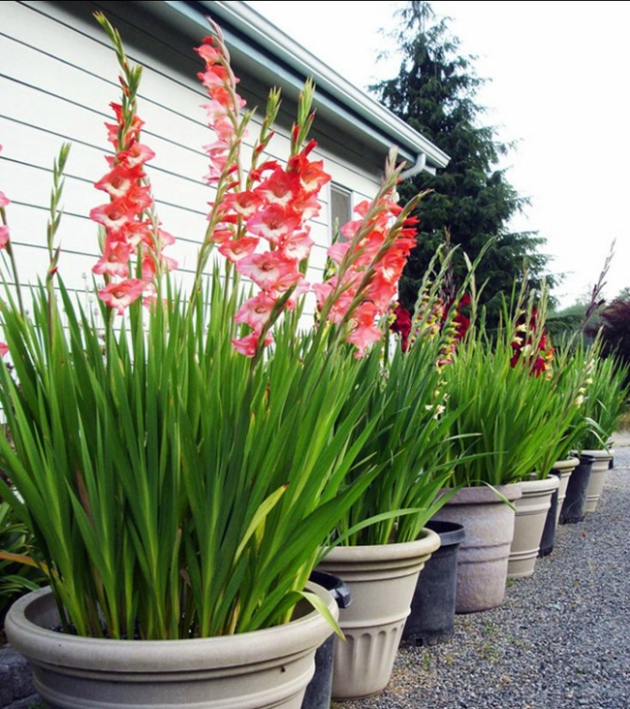
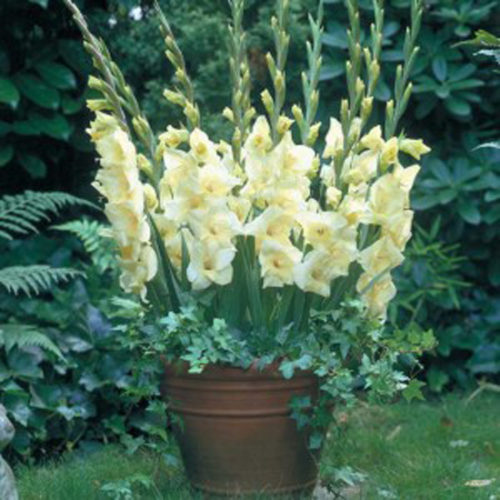

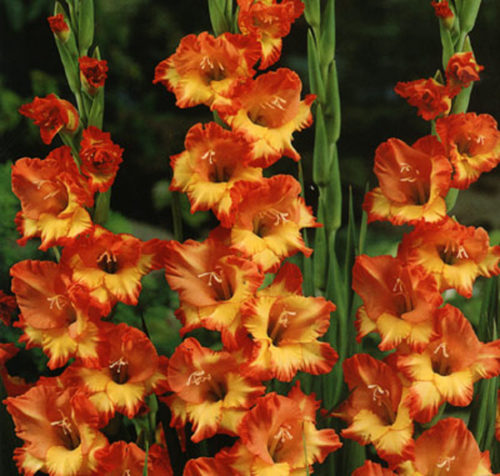
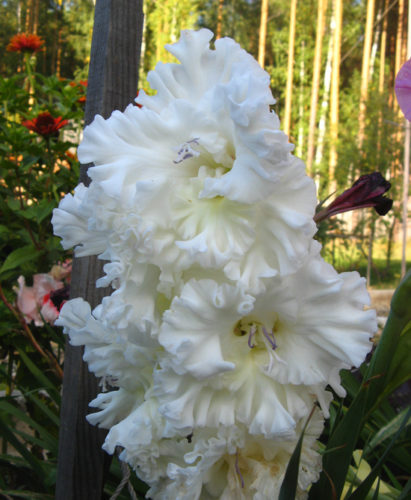
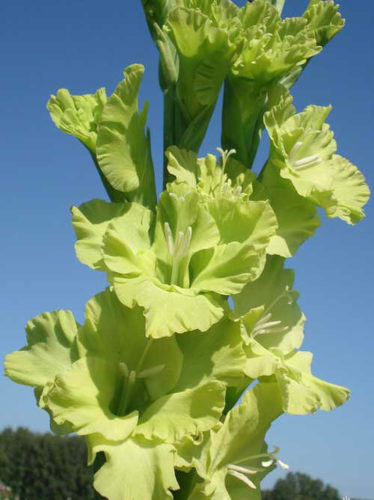
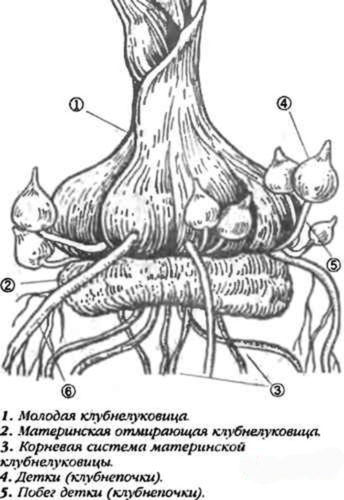
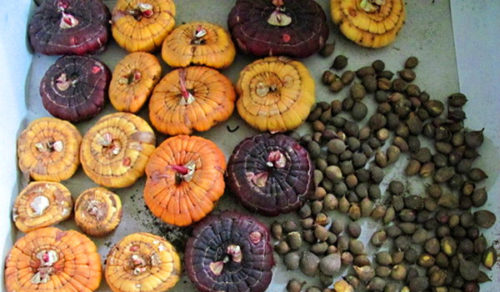





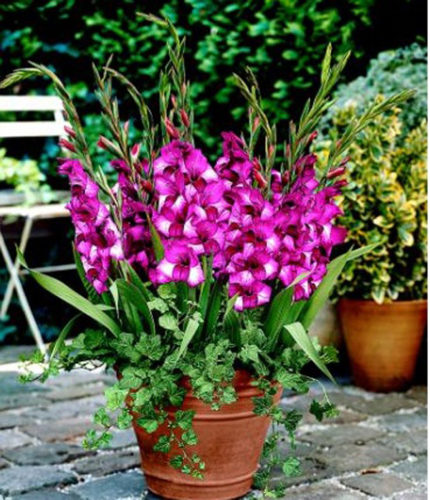

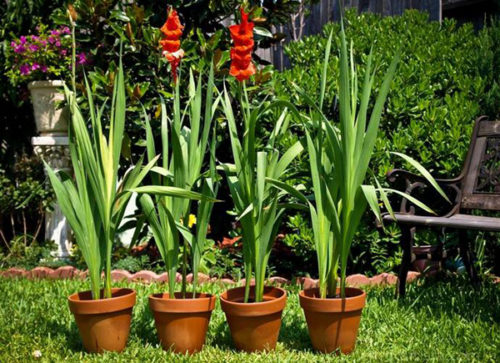
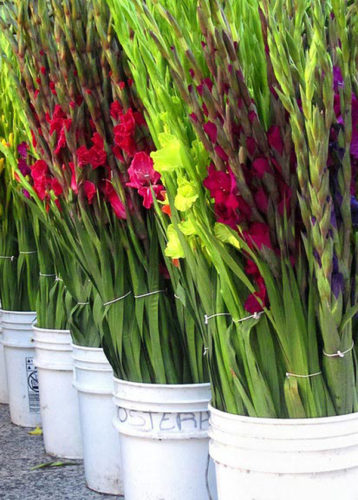


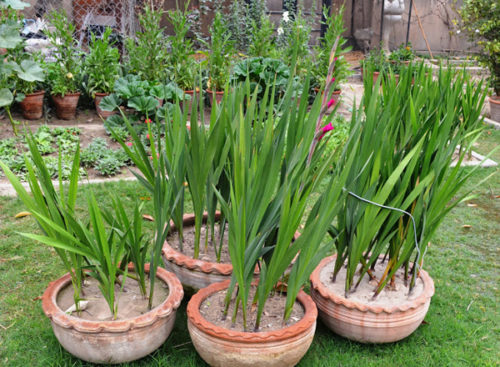












 Start a discussion ...
Start a discussion ...